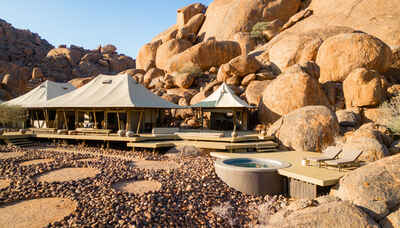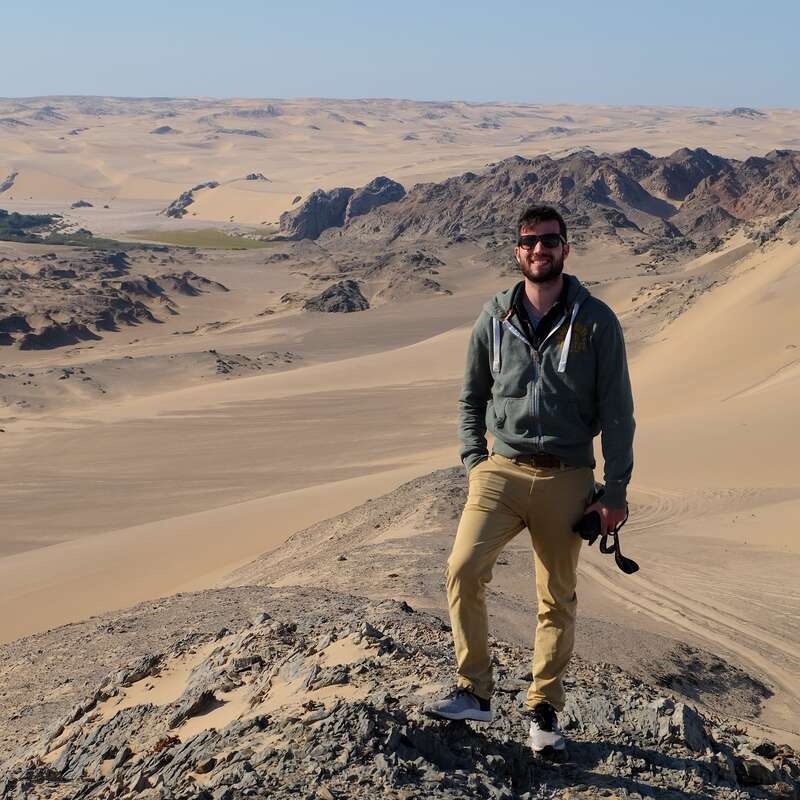About Wolwedans Boulders Camp
Wolwedans Boulders Camp is built at the foot of a granite boulder mountain in the remote south of the private ...
... NamibRand Nature Reserve. A small, exclusive retreat, it is reached by 4WD, a scenic transfer during which we have often see ostrich and several species of antelope.
In a remote and beautiful corner of the NamibRand Nature Reserve, the high-quality Wolwedans Boulders Camp feels quite open and in touch with the landscape – making it an exceedingly peaceful place to relax, whilst doing a little gentle exploring on foot and by 4WD. Let any game be a bonus; come here for the magical ambience and the luxury of privacy and space.
Our view
In a remote and beautiful corner of the NamibRand Nature Reserve, the high-quality Wolwedans Boulders Camp feels quite open and in touch with the landscape – making it an exceedingly peaceful place to relax, whilst doing a little gentle exploring on foot and by 4WD. Let any game be a bonus; come here for the magical ambience and the luxury of privacy and space.
Accommodation
4 tented chalets
Children
Best for 16+
Open
1 Mar–30 Nov
Activities

4WD Safari

Cultural excursion

Horse-riding

Hot air ballooning

Private activities
Traveller reviews of Wolwedans Boulders Camp
7 real, un-edited reviews from Expert Africa's travellers.
Arrived 3 Sep 2017, 2 nights
"Remote luxury!"
Overall rating: Excellent
Arrived 25 Sep 2016, 1 nights
"Fabulous location and upmarket small camp"
Overall rating: Good
Arrived 10 Jun 2016, 2 nights
"Wolwedans Boulders Camp review"
Overall rating: Excellent
Arrived 1 Jun 2015, 2 nights
"Outstanding visit at Wolwedans Boulders Camp"
Overall rating: Excellent
Arrived 2 Mar 2013, 3 nights
"Wolwedans Boulders Camp review"
Overall rating: Excellent
Arrived 11 Oct 2011, 1 nights
"Wolwedans Boulders Camp review"
Overall rating: Excellent
Arrived 17 Oct 2009, 2 nights
"Wolwedans Boulders Camp review"
Overall rating: Excellent
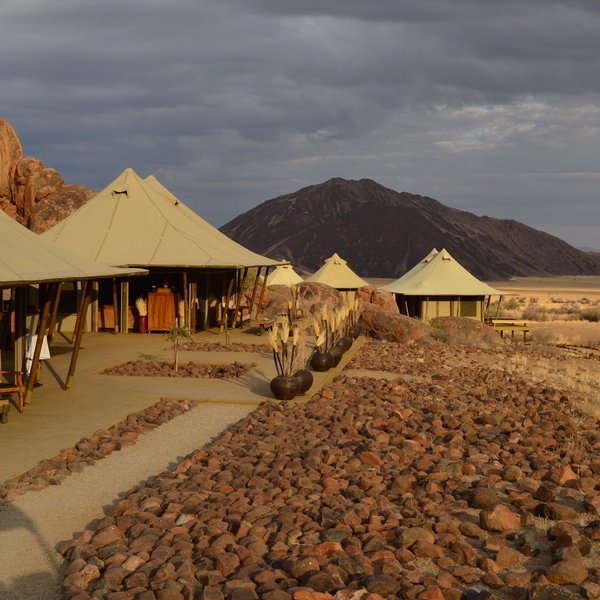
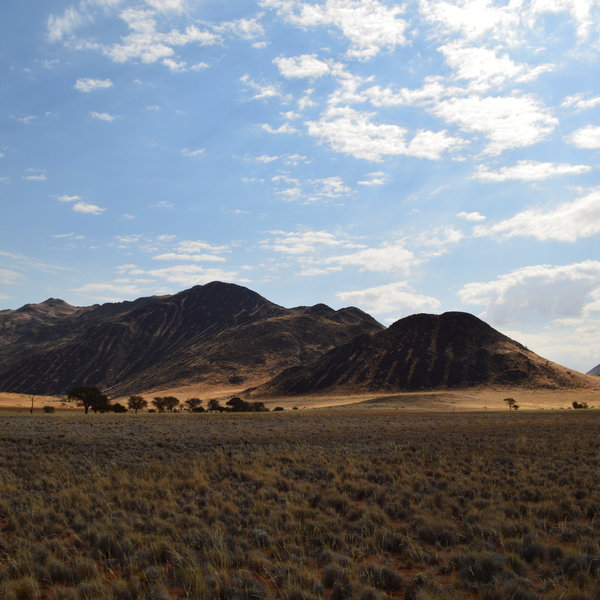
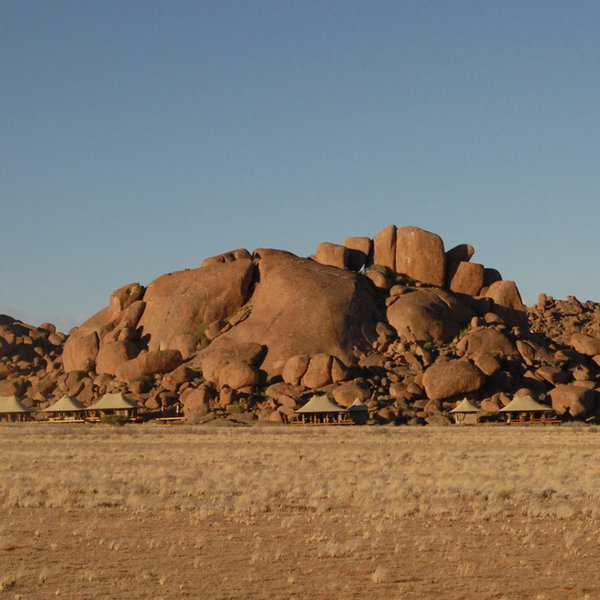
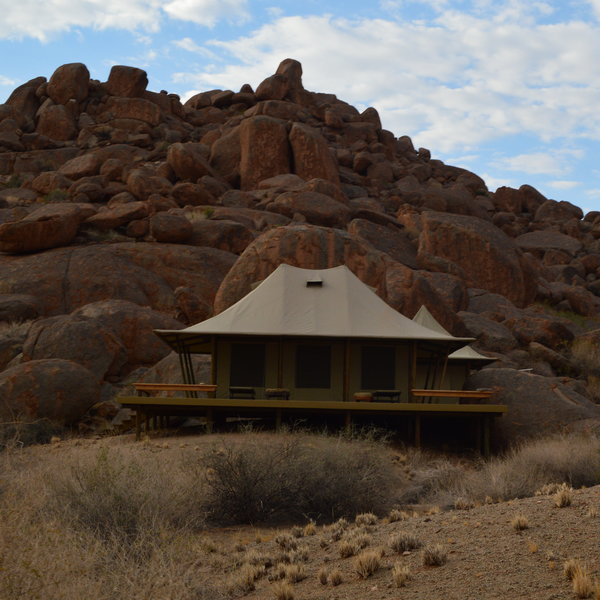
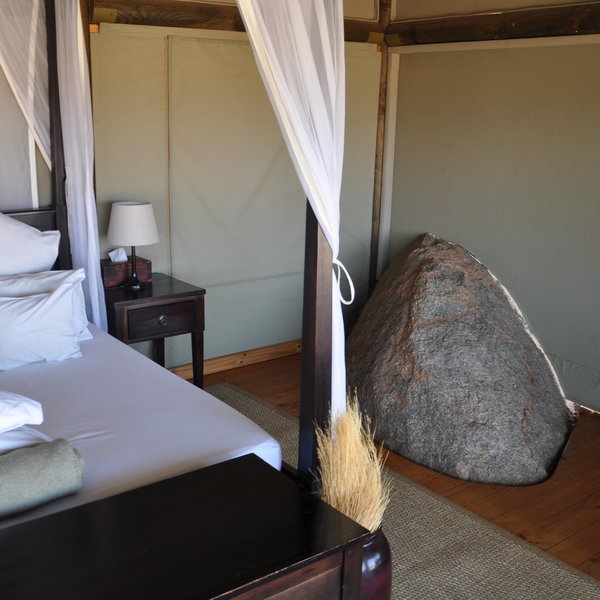
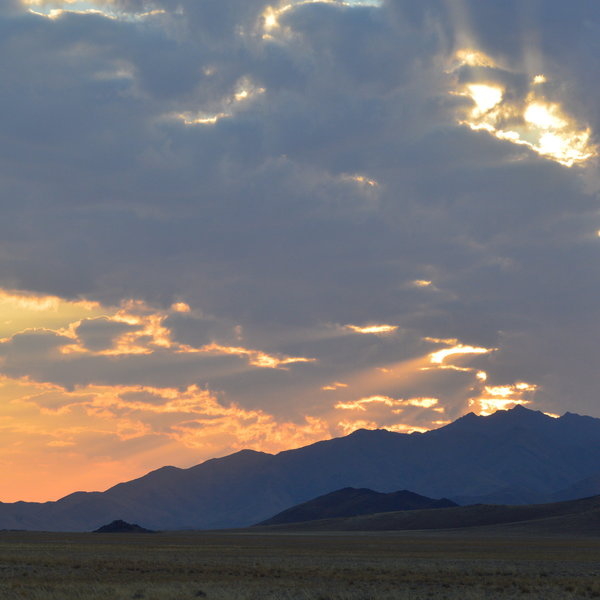
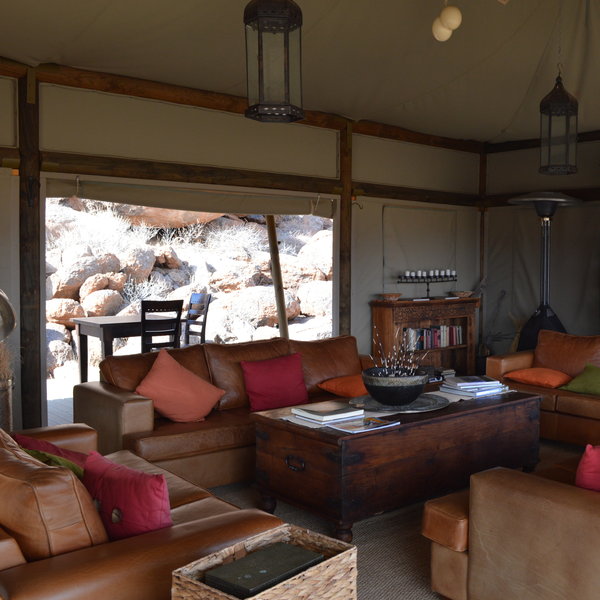
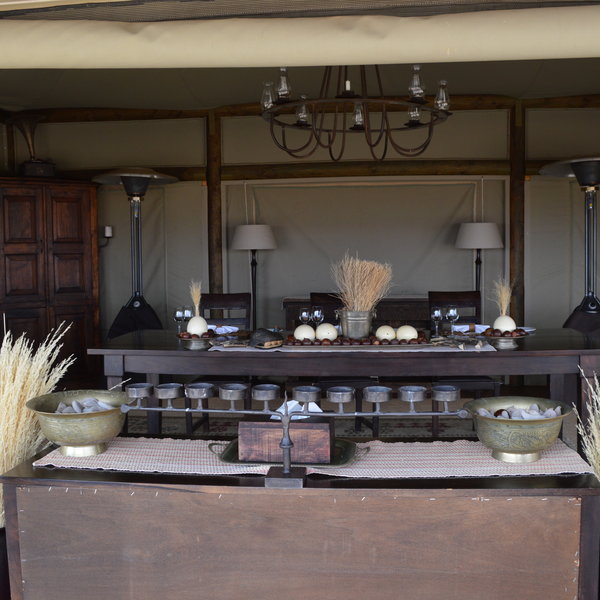
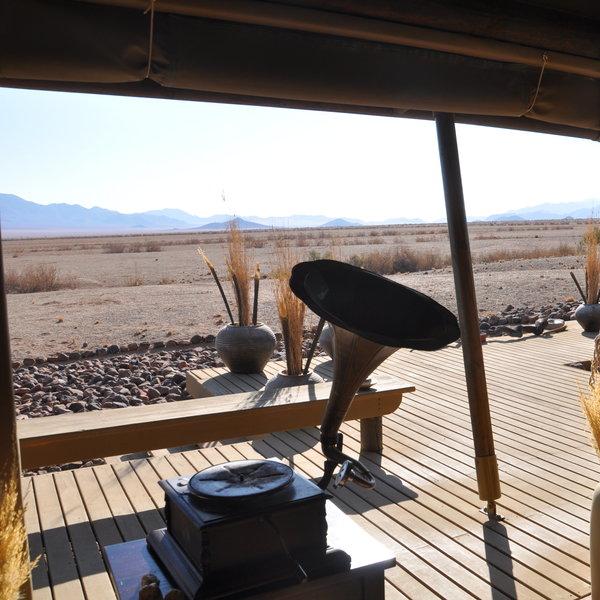
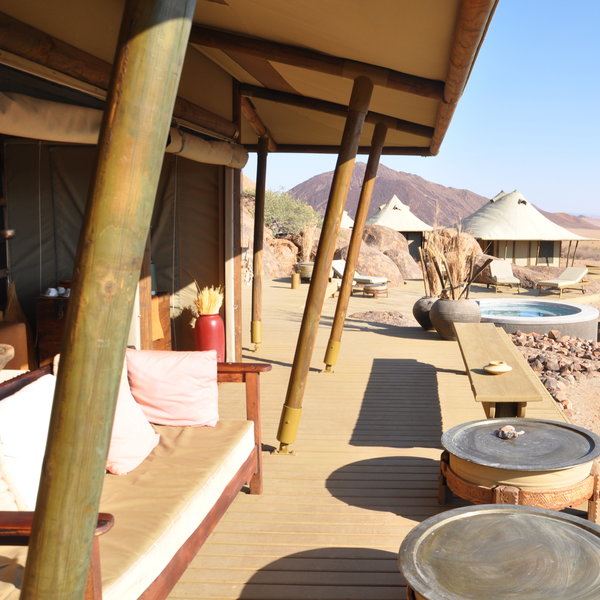
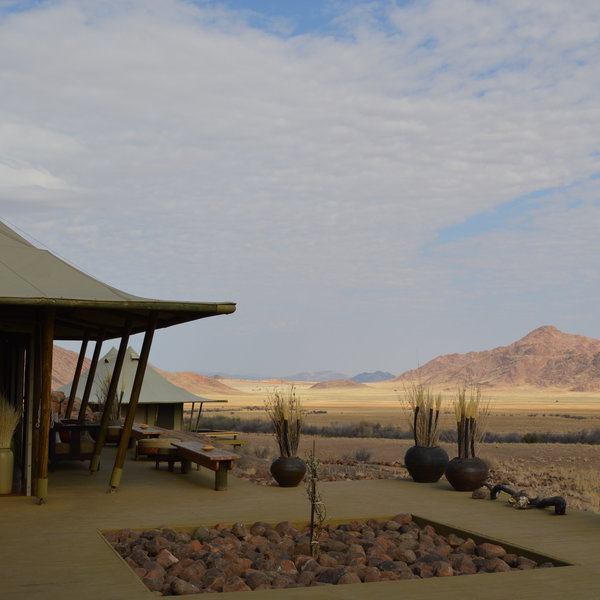
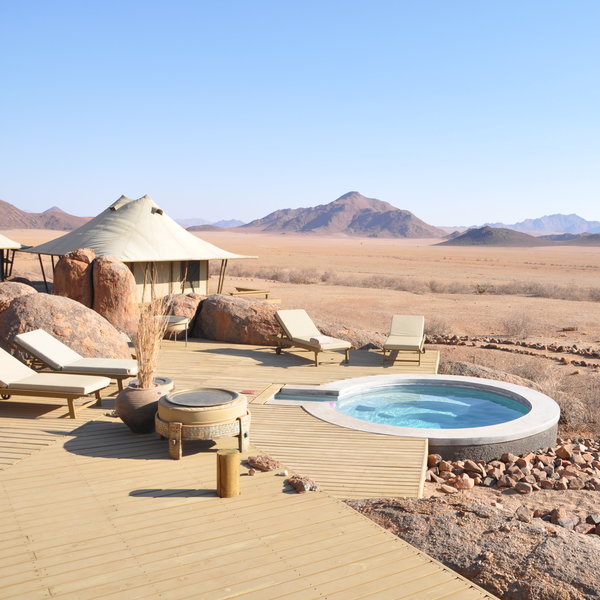
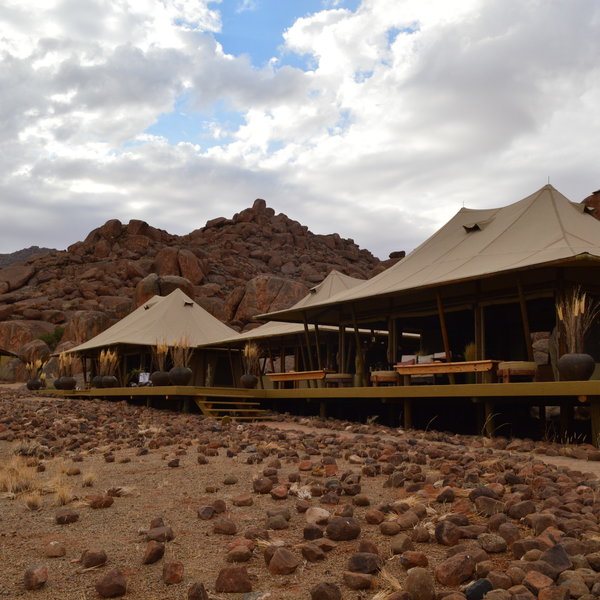
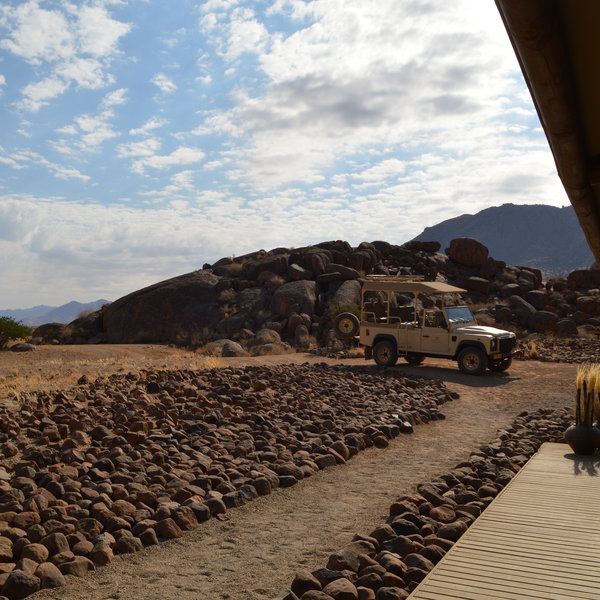
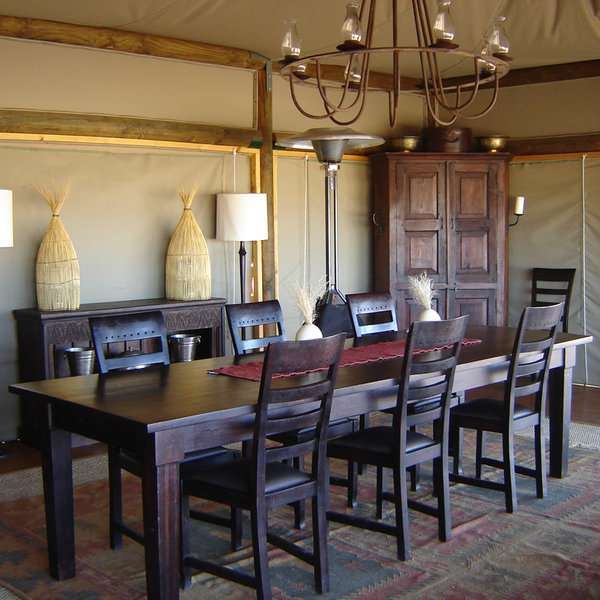
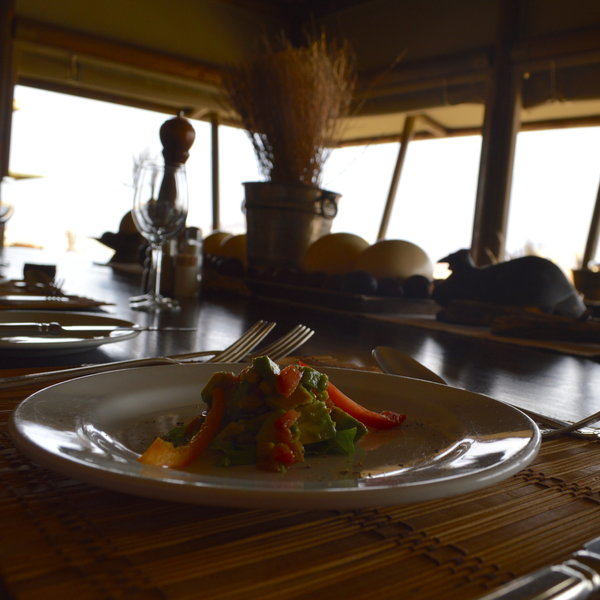
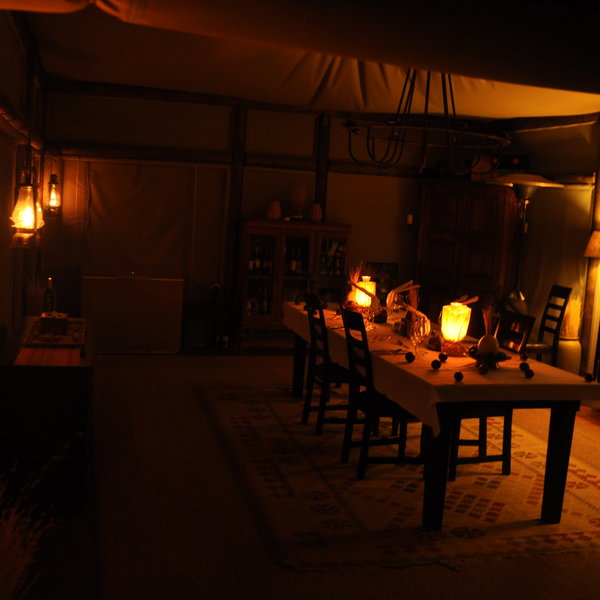
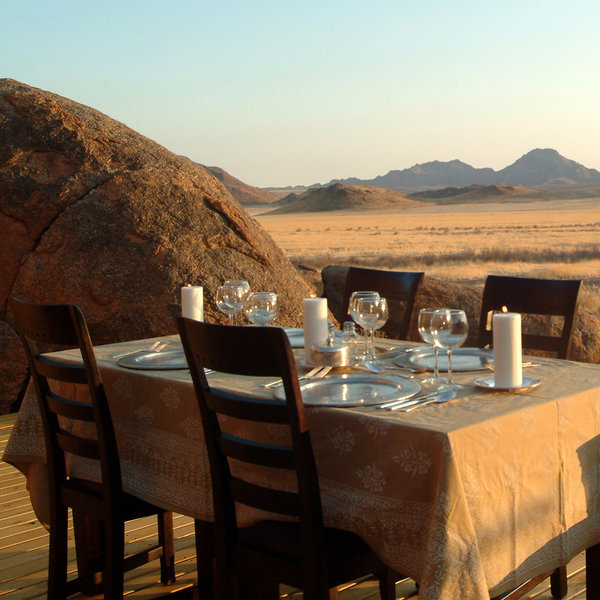

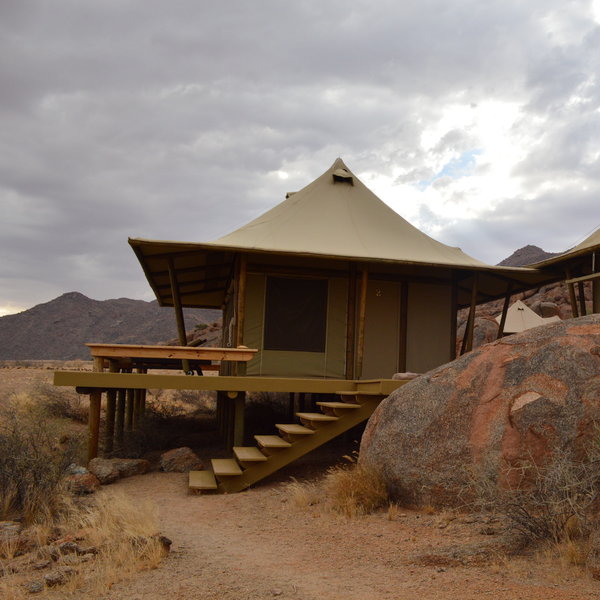
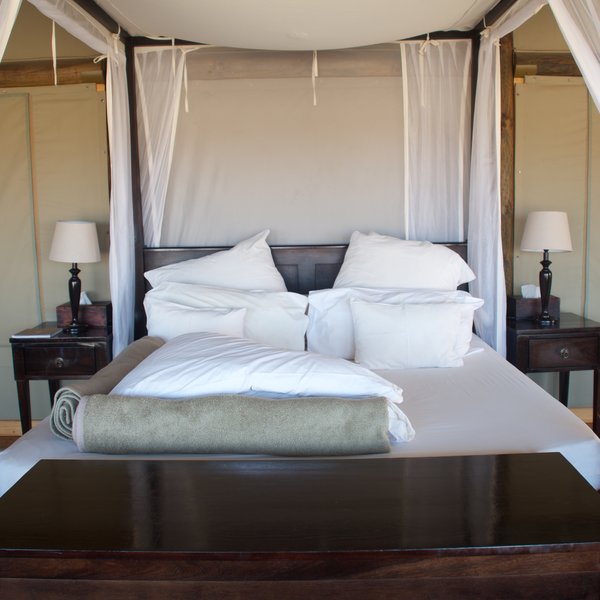
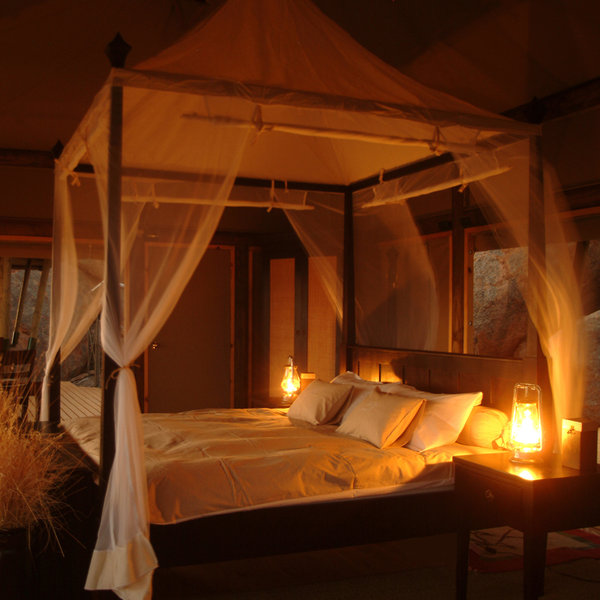
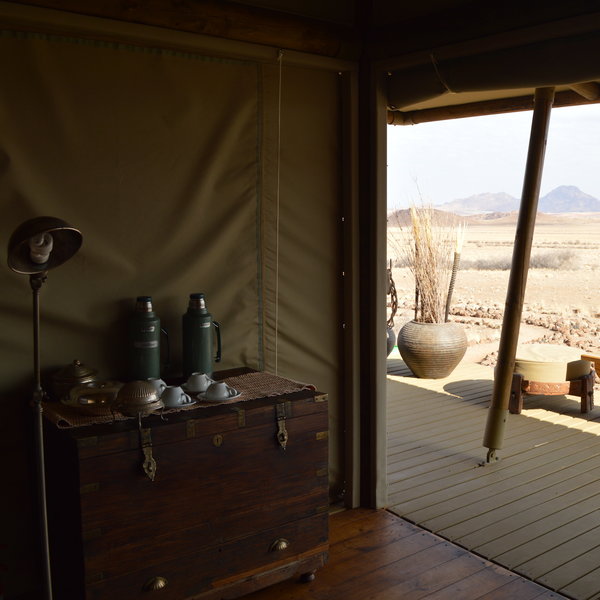
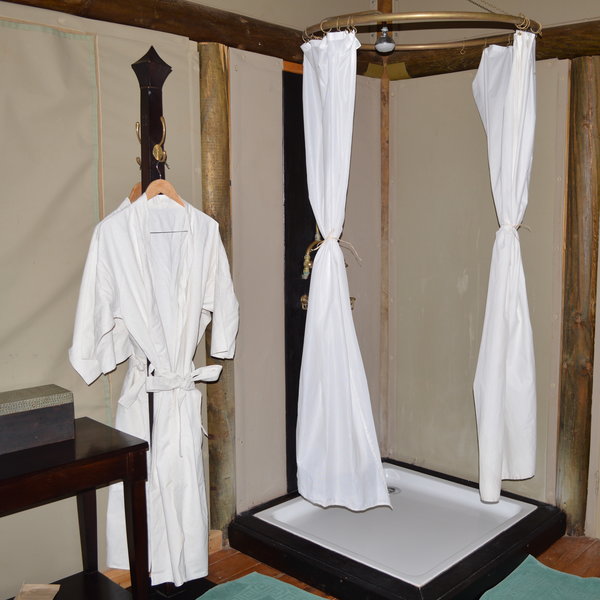
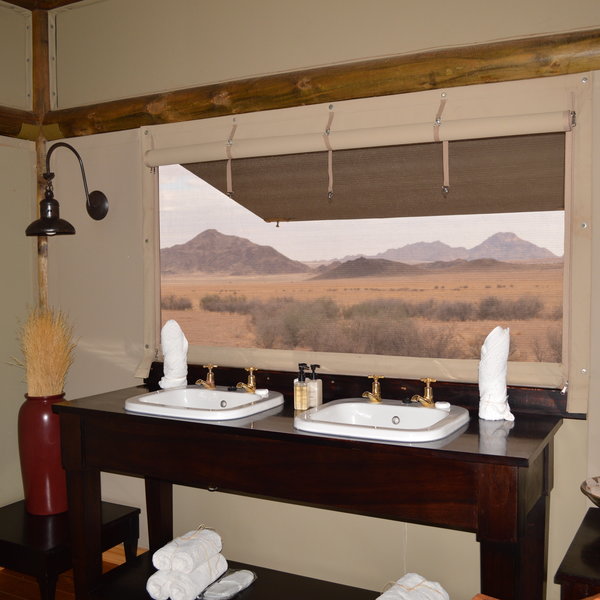
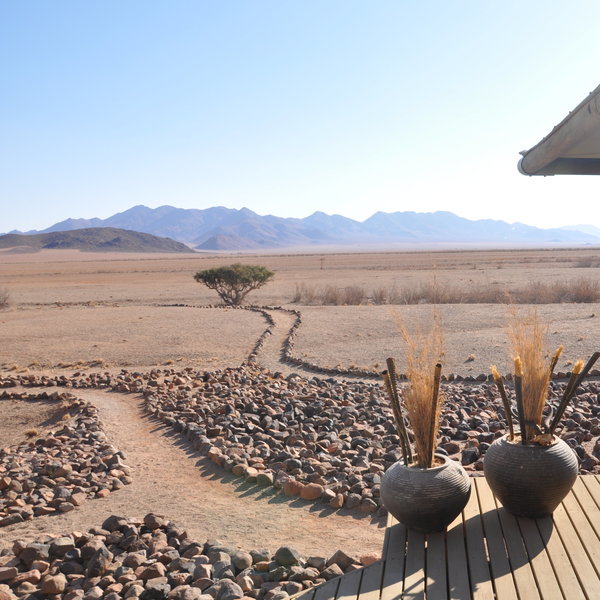
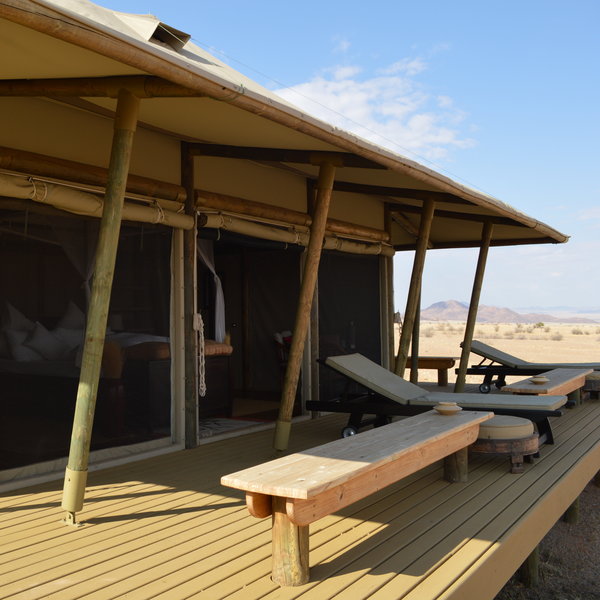
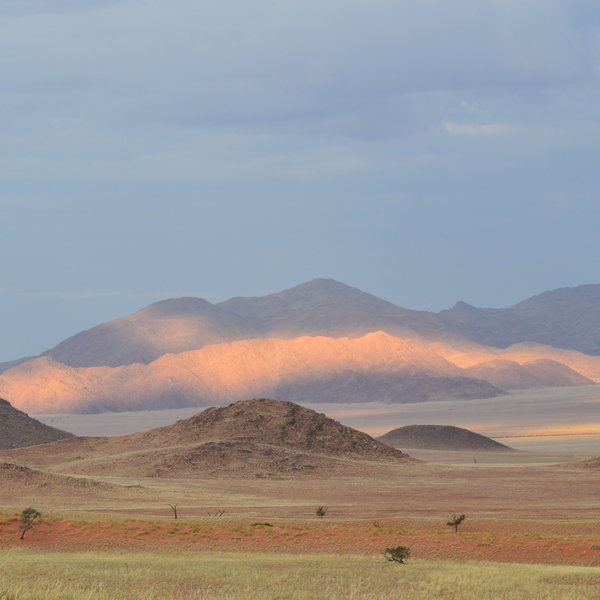
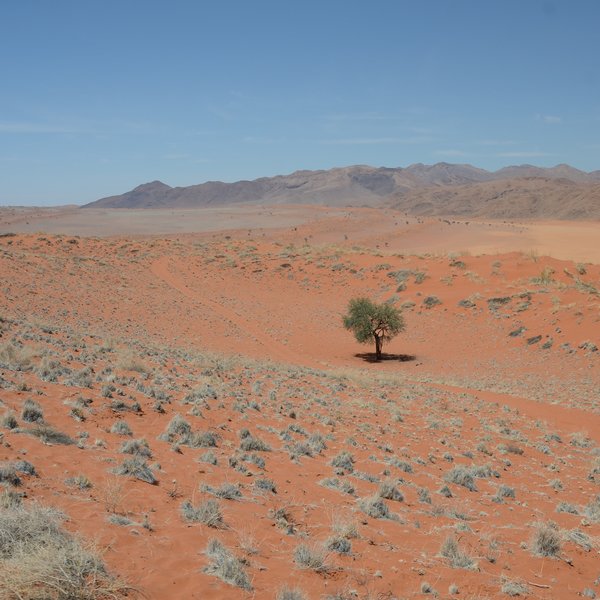
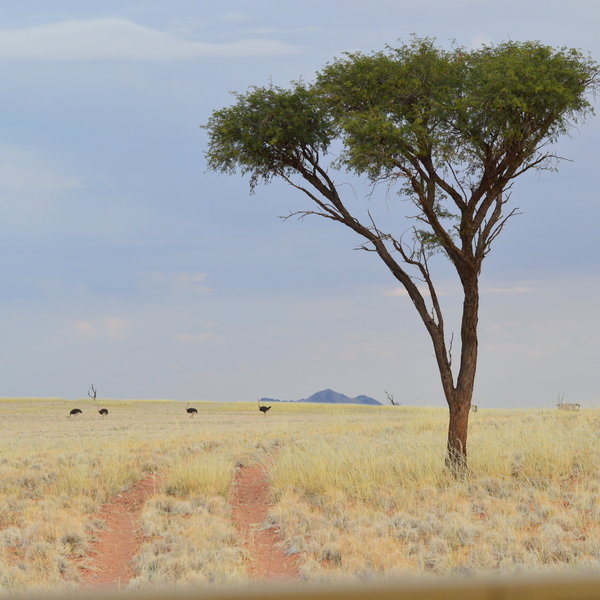
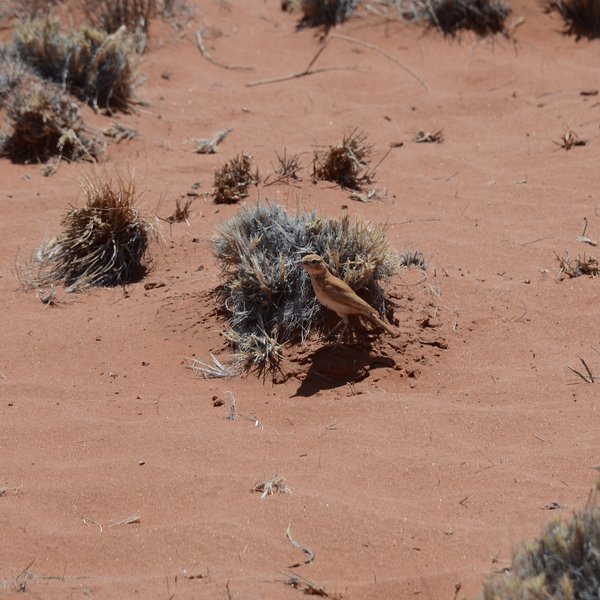
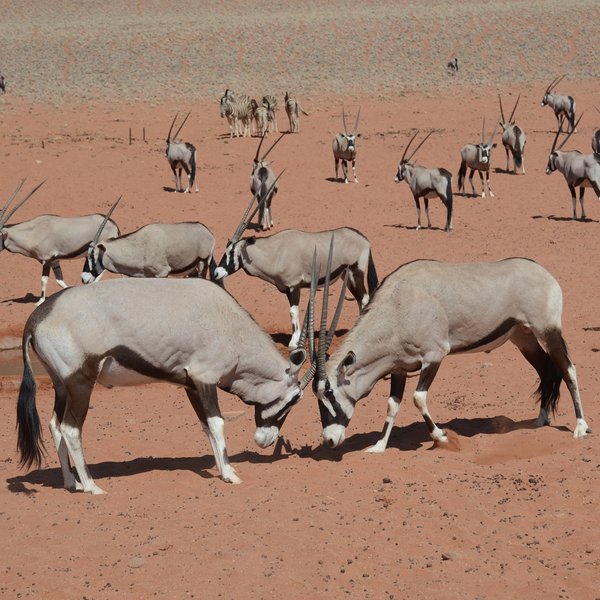
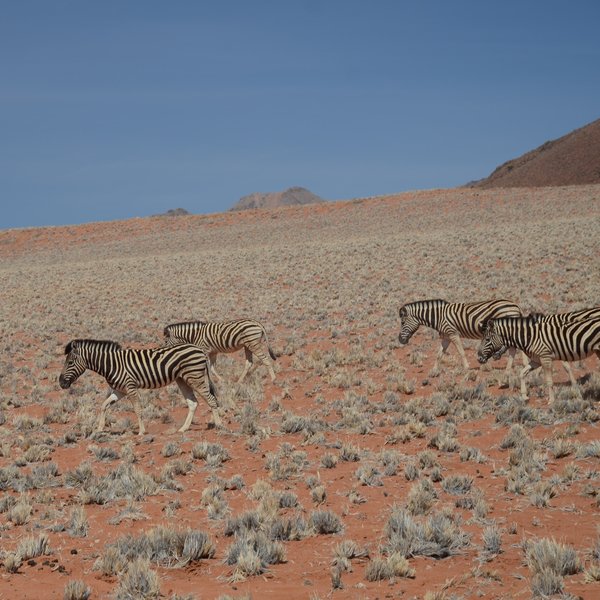
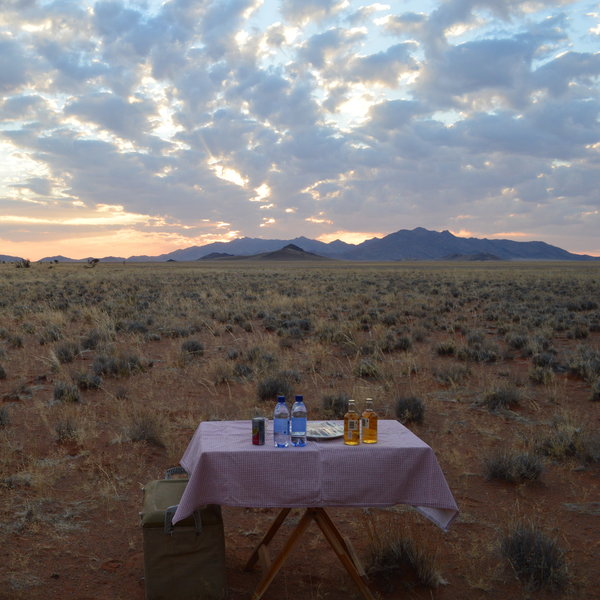
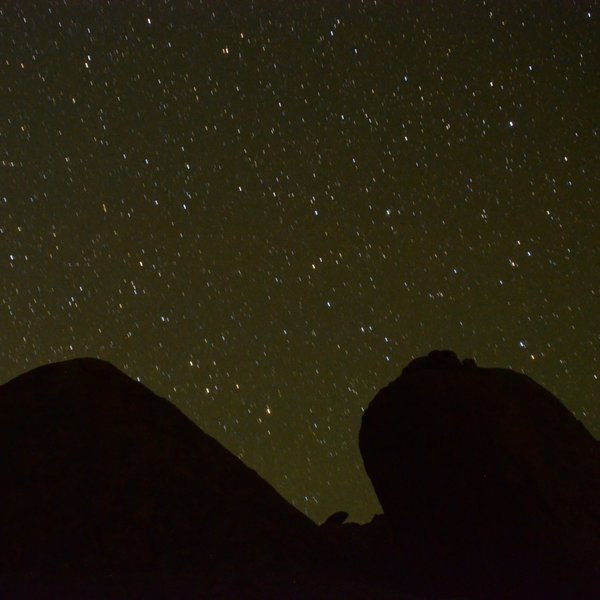
Expert Africa's gallery
When we travel we take lots of photos ourselves to give you a real and un-edited view of the safaris. See our 49 pictures of Wolwedans Boulders to get the candid view.
View galleryWolwedans Boulders Camp: Our full report
Wolwedans Boulders Camp is built at the foot of a granite boulder mountain in the remote south of the private ...
... NamibRand Nature Reserve. A small, exclusive retreat, it is reached by 4WD, a scenic transfer during which we have often see ostrich and several species of antelope.
Boulders shares the reserve with its three sister camps, which lie about 45km further north: Wolwedans Dune Camp, Wolwedans Plains Camp and Wolwedans Desert Lodge.
The four tented chalets at Wolwedans Boulders Camp are built on raised wooden decks with boulders rising up behind them, and seemingly impossible views across open grass plains to the Gorassis Mountain in the distance. Three of the chalets are located in a row to one side of the main area, whereas one sits on its own amidst rocks on the opposite side. Constructed of canvas stretched across simple wooden frames, the chalets are simply but beautifully decorated, each with a large four-poster bed in the centre, elegantly draped with white mosquito netting, and flanked by a dressing table and smaller coffee table and chairs. Roll-up canvas blinds allow air to circulate freely, and open onto a veranda with a couple of loungers and benches – a perfect spot, as we have found over the years, to soak up the views. That said, the path to the chalets passes in front of them, so be sure to roll the canvas down if you are concerned about privacy.
During the winter months, the chalets can get quite cold at night, so the hot-water bottles placed in the beds are a thoughtful added touch. As the wind whips across the plain the tents can also rustle and shake through the night, so each guest is also provided with a pair of ear plugs.
Each chalet has a private bathroom which, although not en suite, is across the deck and less than three metres away from the bedroom. These are fairly big with a shower, flush toilet, double basins and Moroccan lanterns. You can even roll up the bathroom window to admire the views while brushing your teeth or having a shower. Bathrobes, body lotion, shampoo and small guest soaps are provided.
The main area at Wolwedans Boulders Camp consists of a dining tent and a lounge tent built on a vast wooden deck, with the kitchen set between them. The lounge interior is furnished with plush leather couches and a small library and is tastefully decorated in earthy colours with old German furniture, books and lanterns and even a gramophone. In the dining tent, a communal table is set under a rustic lantern chandelier, although weather permitting, dinner may be served on the deck under the stars.
To one side of the main area, set in a semi-circle of boulders, is an open fireplace. On a cool evening on a previous visit in late June, this was a lovely spot to gather before dinner and exchange stories. At the other end of the deck, a small but very inviting poolsits in the wooden deck, surrounded by loungers and making the most of the views over the NamibRand Reserve. It’s also a great spot for sundowners as each day wanes.
Although the camp itself is a wonderful place to relax and enjoy the surrounding vistas, guests at Wolwedans Boulders Camp will explore various aspects of the 2,100km2 reserve. Activities comprise two- to three-hour guided walks, usually in the morning, and 4WD scenic drives in the afternoon. Do note, however, that unlike other camps in the Wolwedans collection, Boulders does not offer environmental walks with a Bushman.
The NamibRand is not primarily a wildlife destination, but the vast reserve is home to gemsbok, springbok, kudu, Hartmann's and Burchell's zebra, giraffe, klipspringer, steenbok and hartebeest. Visitors may also be lucky enough to catch sight of leopard, spotted and brown hyena, black-backed jackal, bat-eared and Cape fox, caracal or one of the cheetah that have been introduced here as part of a conservation programme.
On our last visit in October 2016, the harsh but spectacular setting was the backdrop for many, many oryx, springbok, both Burchell’s and Hartmann’s zebra and a large herd of red hartebeest. Our guide also gave us some brief but informative explanations on points of interest such as sociable weaver nests and the camelthorn acacias, although further information on the geography and geology of the area would have been well received. On a previous visit, in June 2014, we were not only stunned but also very lucky to spot no fewer than ten aardwolves and eight black-backed jackals on our afternoon nature drive. Even our guide was excited about these sightings, though he was quick to point out that we were luckier than most!
For the ornithologist, there are over a hundred species of birds to be spotted, albeit at quite low densities. Our birding highlights included the endemic dune lark, Rüppell’s korhaan, greater kestrel and lappet-faced vulture.
The NamibRand Nature Reserve is also one of the best places in Namibia to see high densities of the mysterious fairy circles, with whole hillsides pock-marked with these intriguing spots. Theories abound on the formation of these circles, from underground termites living in a circular nest and chewing the roots of the grass, to toxic plants poisoning the ground or a competition for resources by the grasses – but the jury is still out.
Visitors should note that it is not practical or possible to visit Sossusvlei from Boulders Camp. For those who want to make the most of Namibia's desert we recommend two nights at one of the lodges in the Sesriem area followed by two special nights at Wolwedans.
Activities
4WD Safari
Cultural excursion
Horse-riding
Hot air ballooning
Private activities
Families & children
- Attitude towards children
- Wolwedans welcomes children over the age of six years old.
- Property’s age restrictions
- The minimum age limit is six years, but younger children can stay here provided the whole camp is booked exclusively for the family.
- Special activities & services
- None
- Equipment
- None, although the camp will put one extra bed in a tent for a child aged 6–12 years to share with his/her parents.
- Generally recommended for children
- Boulders has a particularly adult atmosphere and part of its appeal is the remoteness, peace and tranquillity. It would work for families with older children who have an appreciation of these qualities and a love of the natural world. If you plan to travel with younger children, either the Mountain View Suite at Wolwedans Dunes Lodge or Wolwedans Private Camp might be better options.
- Notes
- There are no railings around the raised decks in camp. Children must always be under the supervision of their parents.
Food & drink
- Usual board basis
- Full Board & Activities
- Food quality
- As at all the camps in the Wolwedans Collection, food is a very big part of a stay at Boulders Camp. When we stayed here in October 2016, we found the meals to be generally very good with beautiful presentation.
The day starts with a gentle 'Knock, knock, good morning!' as one of the team delivers a flask of hot water so you can make a cup of tea or coffee at the coffee station in your chalet.
A substantial breakfast is available before heading out on the day's activities. Guests are invited to select as many items as they would like from the menu. On our stay the choices included cereal, fruit salad, yoghurt, bread rolls and toast, cold meats, cheese, pancakes and oats or porridge, as well as a hot cooked breakfast. In addition to coffee and tea, there were fruit juices, hot chocolate and cappuccino.
Lunch is usually three courses, but despite that we found it was quite a refreshing, light meal. We started with baked camembert, which was followed by a fresh seafood salad and rounded off with almond cheesecake.
Dinner is served at around 8.00pm, although this could be as late at 9.00pm in summer, and is sometimes a barbecue. We sat down to a five-course meal, which started off with a description of the menu in both English and the local Nama language, after which the team broke into some enthusiastic singing. We thought it was really fun!
Our first course, a very simple appetizer of smoked salmon on a green salad, was followed by a delicious mushroom, tomato and melted cheese stack. A delightfully creamy cauliflower soup followed this with an added crunch provided by sunflower seeds. The main course was fillet of oryx served with a red wine sauce alongside red cabbage, basmati rice and vegetables. A poached pear with a hint of cinnamon made for a simple, sweet ending to the meal. - Dining style
- Group Meals
- Dining locations
- Indoor and Outdoor Dining
- Further dining info, including room service
- No
- Drinks included
- Drinks are included at Wolwedans Boulders Camp with the exception of imported and premium-brand spirits, wines and champagnes. These can be ordered and paid for locally.
The water is too salty to drink at Boulders. It is fine for brushing your teeth or showering but a flask of fresh water is provided in your room to drink and bottled still or sparkling water is available.
Getting there
- Location
- NamibRand Nature Reserve, Namibia
- Ideal length of stay
- Three nights minimum stay is required at Boulders Camp, with fixed arrival days being Monday, Thursday, Friday or Sunday.
- Directions
- Wolwedans Boulders Camp is situated within the NamibRand Nature Reserve. Drive past the entrance to the Wolwedans farmhouse/reception on the C27 until you reach the D827. Keep right and continue for a further 13km. Turn right at the gate 'Aandster', and drive a further 9km to Aandster Farm. After checking in here you will meet your guide then take a 4WD scenic transfer of about 15km to the camp. There is also an airstrip next to Aandster Farm for those guests on a fly-in.
- Accessible by
- Self-drive or Fly-and-Transfer
Special interests
- Photography safaris
- The NamibRand Nature Reserve is one of Africa's largest private sanctuaries. The diverse landscapes, from huge red sand dunes to vegetated inter-dune valleys, gravel plains and imposing mountains makes for spectacular photography in Namibia.
- See ideas for Photography safaris in Namibia
Sustainability
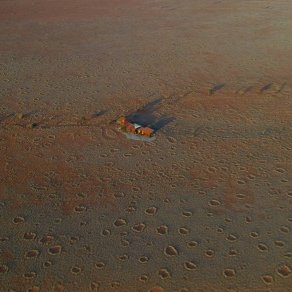
Adopt-a-fairy-circle with Wolwedans
Re-defining the ‘off the beaten track’ experiences, Boulders Safari allows guests to balance out the privacy and silence of a remote camp with adventure-filled activities. One example is the opportunity to take a fairy circle hot-air balloon ride over the NamibRand Nature Reserve. Perhaps one of the most creative and innovative initiative for conservation in the entire Namibia is Boulders Safari’s ‘adopt-a-fairy-circle’ programme.
Found only along the edge of the Namib Desert, the mysterious bare circles in the sand have got the name fairy circles, as no one holds a clear answer as to how these circles are formed or what is they purpose. Boulders Camp encourages guests to ‘adopt’ one of the fairy circles, and therefore benefit conservation programmes ran by NamibRand Conservation Foundation where 100% of the proceedings go.
In return, the foundation directs 30% of the money towards environmental conservation and education research ran by NamibRand Desert Research and Awareness Centre. Another 30% of the funds go to Namib Desert Environmental Education which aims to teach children about the importance of the natural environment through practical, hands-on activities. The remaining 40% is allocated for supporting other conservation projects in the southwestern Namib region.
The ‘adopt-a-fairy-circle’ initiative is a proof that creativity and innovation work hand in hand with conservation at Boulders Camp, who in 2015 has received Eco-Awards Namibia’s highest accreditation of five desert flowers.
See more great sustainability projects in Namibia
Communications
- Power supply notes
- There are no plug points in the chalets, but there is a small charging station in the main area, next to the kitchen. Adaptors are not available on our visits and we recommend that travellers bring their own.
- Communications
- Boulders Camp has radio communication with the operations office at the main reception, about 45km away. There is no cellphone reception here and there are no phones in the chalets. There is also complimentary WiFi in the main area,
- TV & radio
- None
- Water supply
- Borehole
- Water supply notes
- The showers in each tent are plumbed in and the camp has flushing toilets.
Health & safety
- Malarial protection recommended
- No
- Medical care
- The guides are first-aid trained, but the closest doctor is in the town of Mariental. In a medical emergency, guests would be evacuated by air to Windhoek.
- Dangerous animals
- Moderate Risk
- Security measures
- None
- Fire safety
- There are fire extinguishers in the main area and also by each tent.
Useful info
- Disabled access
- Not Possible
- Laundry facilities
- There are no laundry facilities at Boulders Camp.
- Money
- There is a safe in each tent. Boulders Camp does not offer any currency- exchange facilities.
- Accepted payment on location
- Wolwedans accepts cash (Namibian dollars or South African rands), and Visa and MasterCard. They do not accept American Express or travellers’ cheques.
Plan and book your trip with Expert Africa
All of our trips are tailor-made, so we'll always adapt them to suit you. Talk to an Expert and let us plan and arrange your perfect trip.

Talk to an Expert
Call or email us now! We’ll match you with the Specialist in our team who is best suited to help you. Then together we can start planning your trip.

Set up your itinerary
Based on our experience and your ideas, your specialist will create a detailed, costed itinerary. We’ll refine it together, until we have a trip that you’re perfectly happy with.

Prepare for your trip
The same Specialist will make the seamless arrangements for your trip, send you detailed travel documents, and be available to answer any questions before you depart.

Travel with peace of mind
After you set off, you’ll be cared for by our partners in Africa, most of whom have worked with Expert Africa for decades. And if you ever need us urgently, we’re available 24/7.

When you return
We love to learn about your trip, and so will always be grateful if you’ve the time to give feedback to your Specialist when you return.
Wolwedans Boulders Camp's location
Look closer at the environment and surroundings of Wolwedans Boulders.
Excursions from Wolwedans Boulders
Optional extra day-trips and excursions possible whilst you're staying at Wolwedans Boulders. Talk to us: these are usually best arranged before you go.
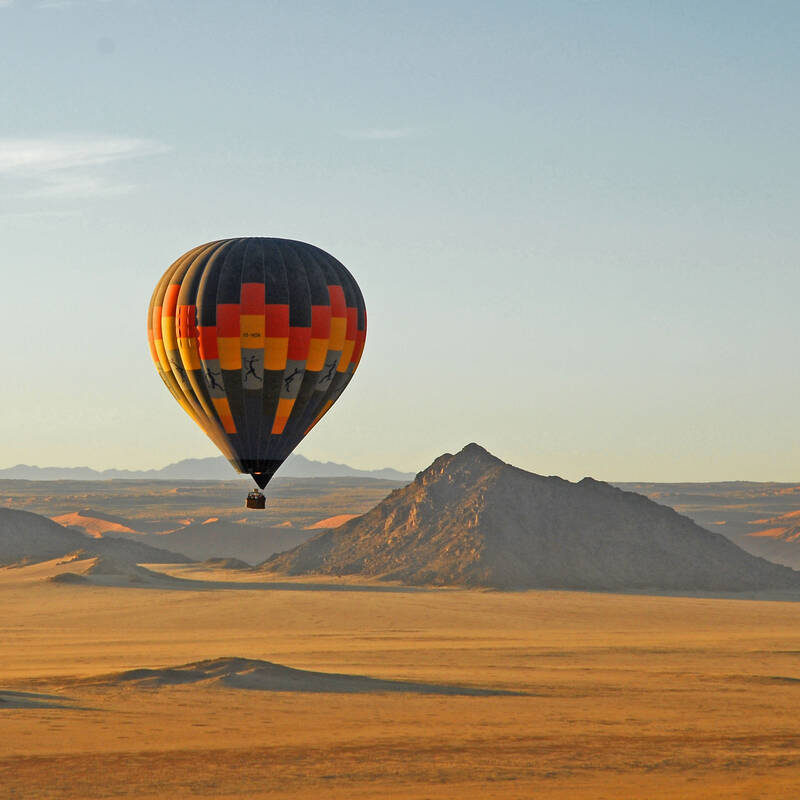
Ballooning in the Namib Desert
Half day, including breakfast
Ballooning over the world’s oldest desert is an experience you shouldn’t miss. Enjoy spectacular views as the sun rises over the dune-covered plains and rocky mountains of the Namib Desert. You may even spot the occasional oryx or black-backed jackal punctuating the landscape below.
More about Ballooning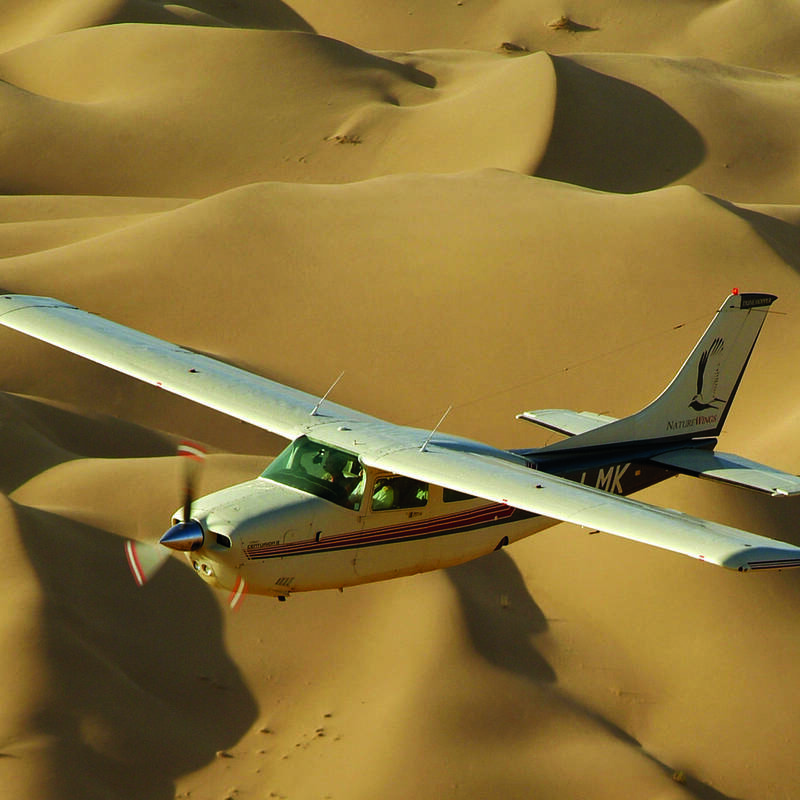
Scenic flights in Namibia
Variable, depending on the flight
Namibia is famed for its stark beauty and boundless desert vistas and there is no better way to soak these in than from the air. A scenic flight gives you a unique perspective on this stunning and varied country, and may even provide a bird’s-eye view of areas that are out of reach to those restricted to terra firma.
More about Scenic flightsOther lodges in NamibRand Nature Reserve
Alternative places to stay in this same area.
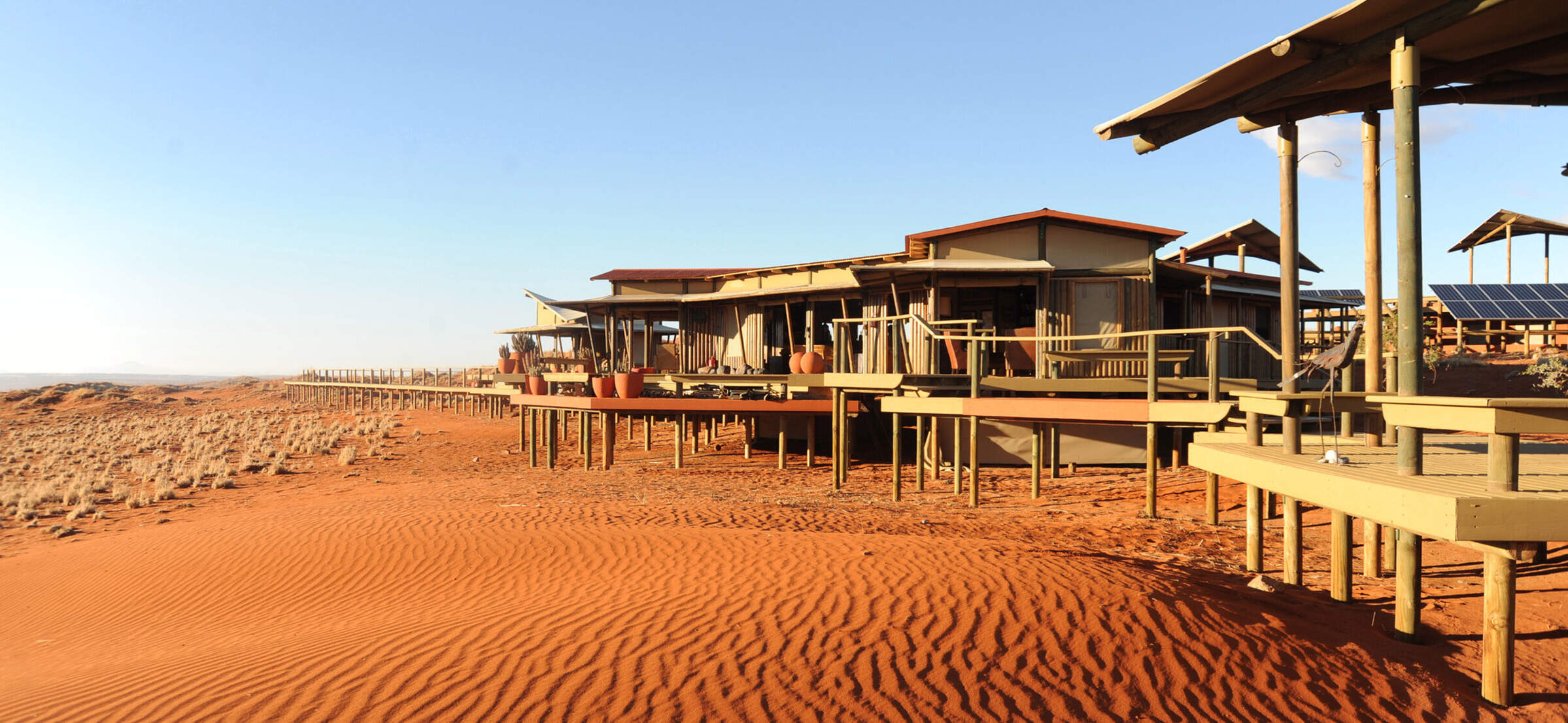
Wolwedans Desert Lodge
Wolwedans Desert Lodge is a beautiful camp in a stunning setting on the NamibRand Reserve. Stay here for a luxurious escape into the wilderness.
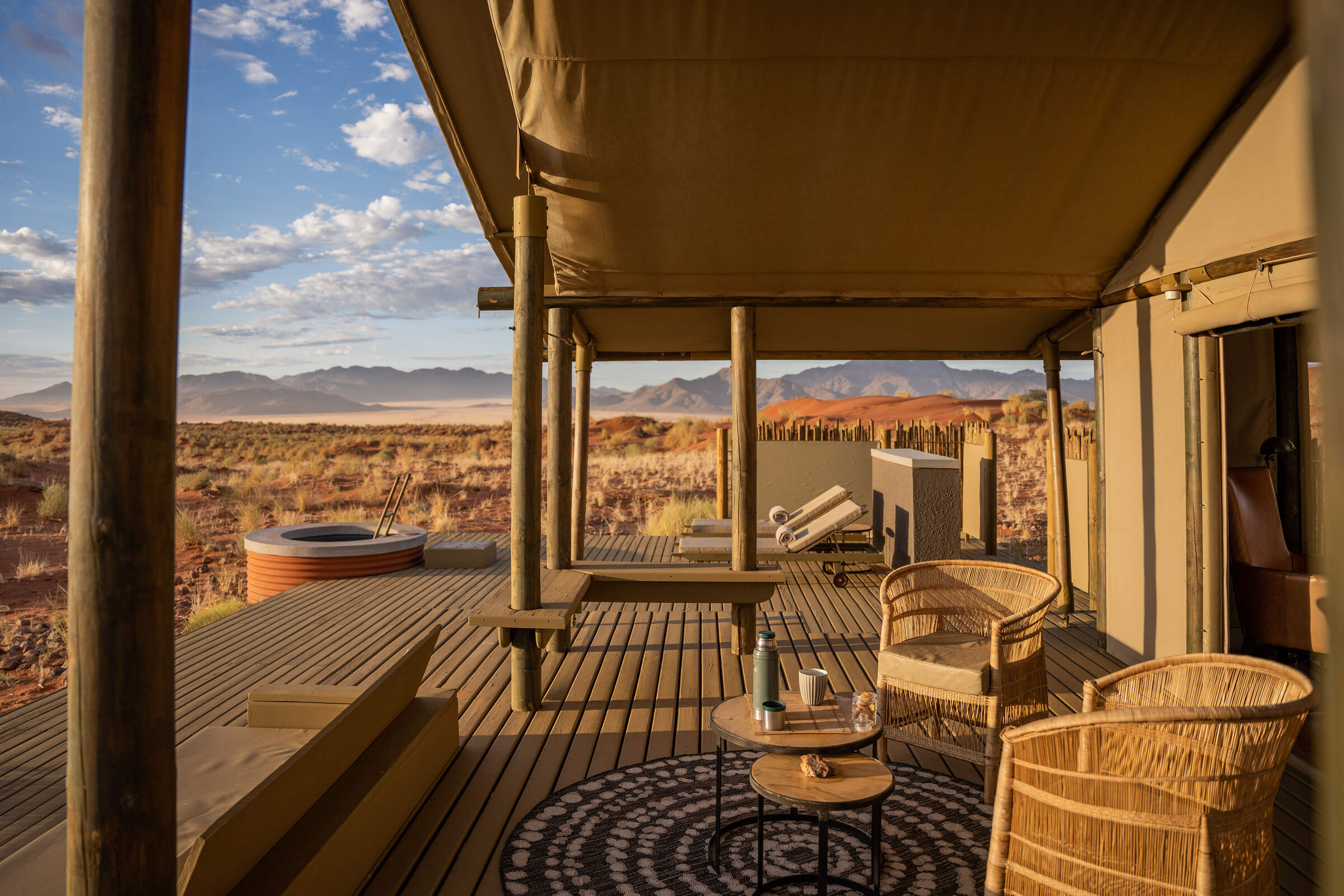
Wolwedans Dune Camp
Small and intimate with excellent service and great guiding, Wolwedans Dune Camp is a luxurious escape in a beautiful location.
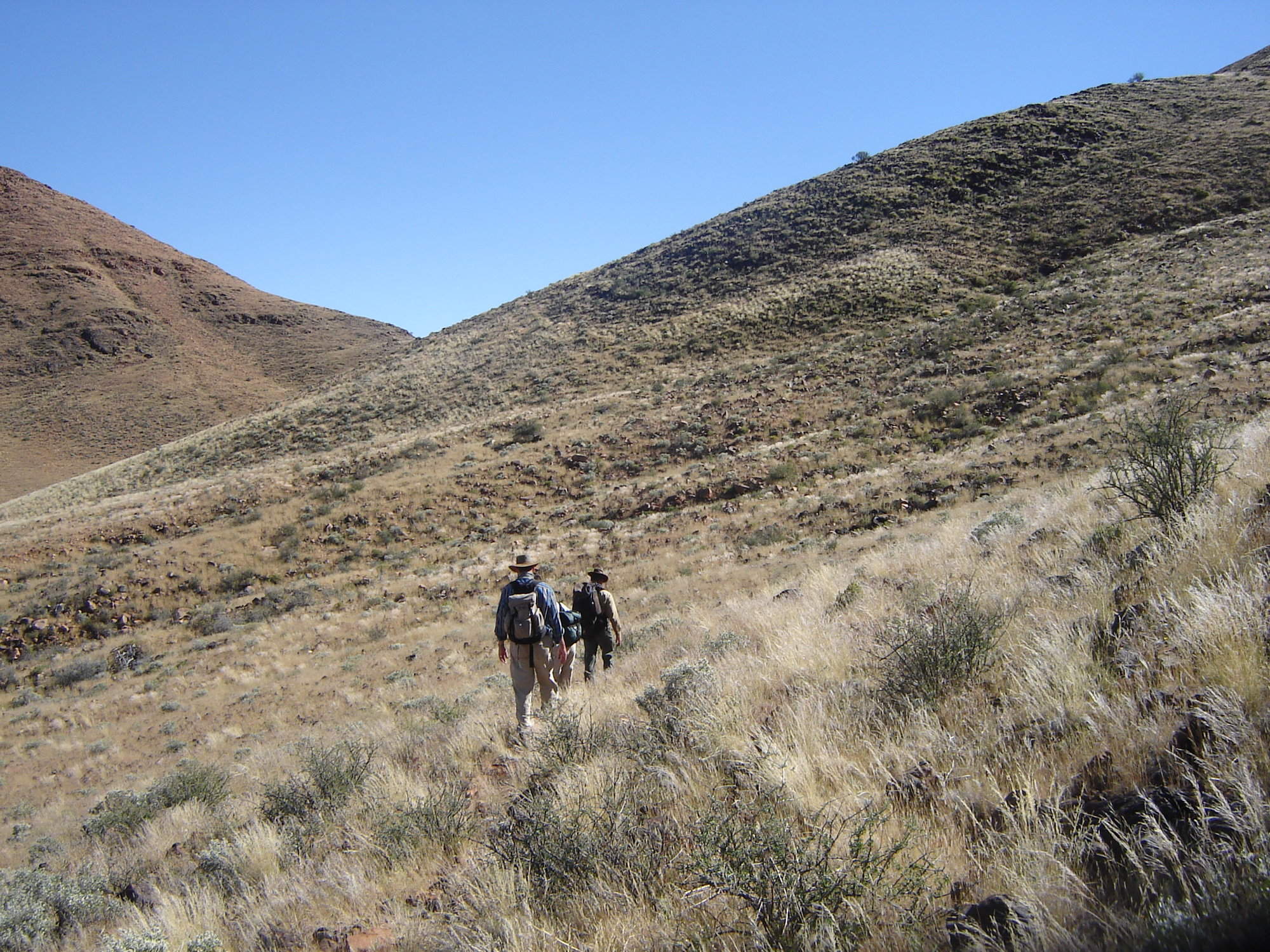
Tok Tokkie Trails
Escape the car and explore the spectacular Namib Desert on foot with an expert guide from Tok Tokkie Trails.
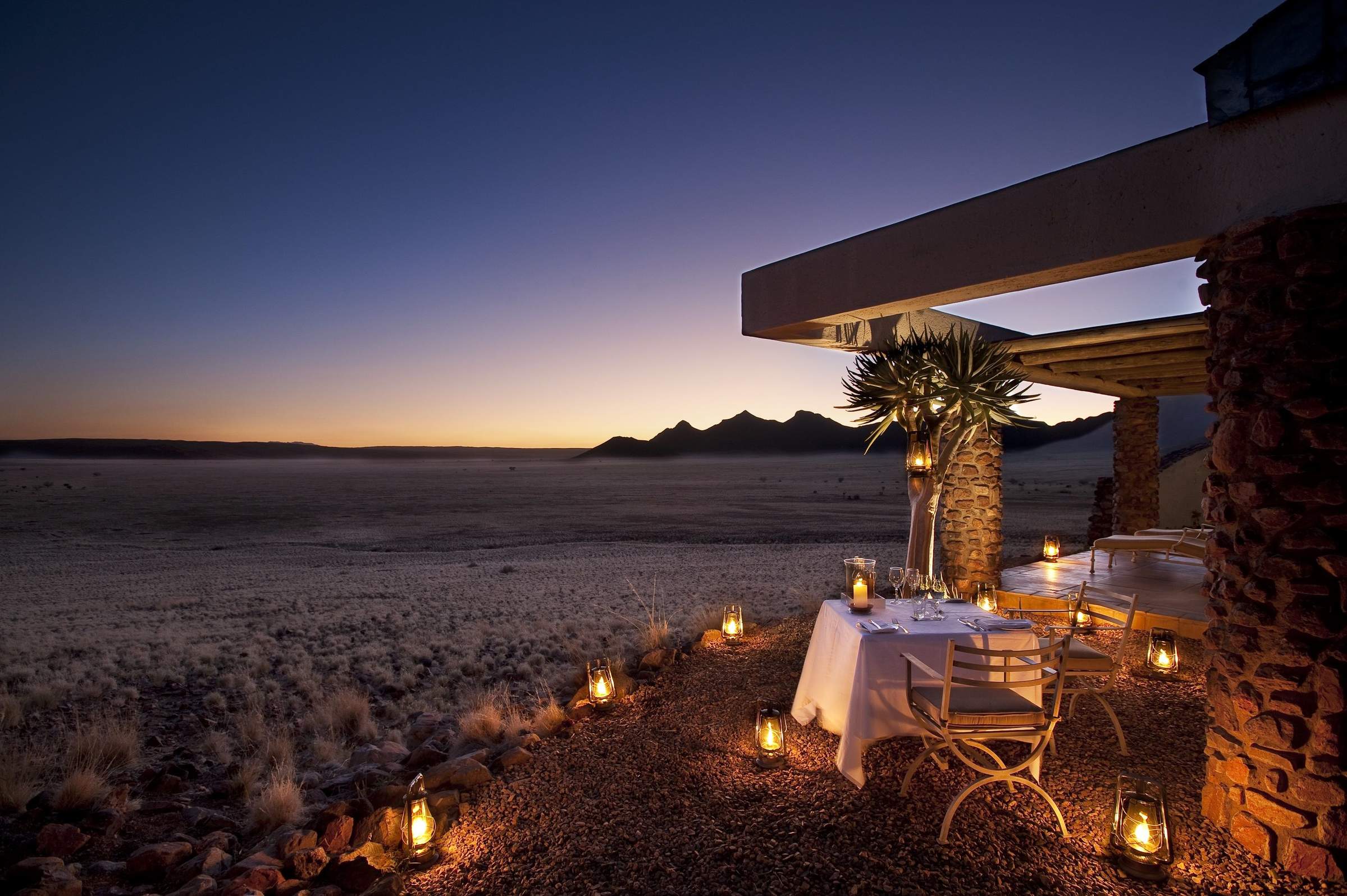
Sossusvlei Desert Lodge
Sossusvlei Desert Lodge is located on the NamibRand Reserve and offers a range of activities as well as high levels of comfort and service.
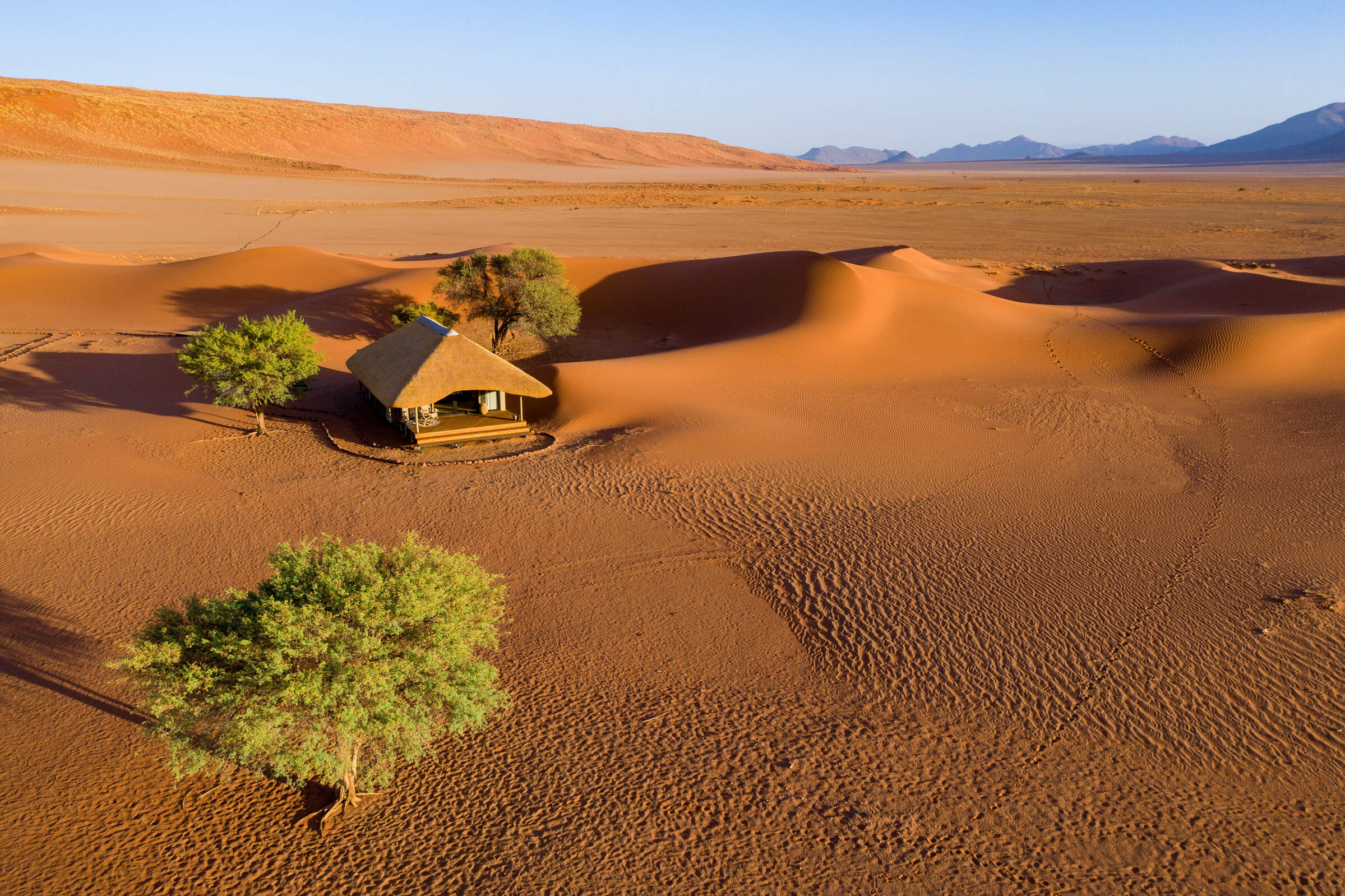
Kwessi Dunes
Kwessi Dune Lodge is a new property in the NamibRand Nature reserve promising to offer a luxurious stay in the wonderfully remote NamibRand Reserve.
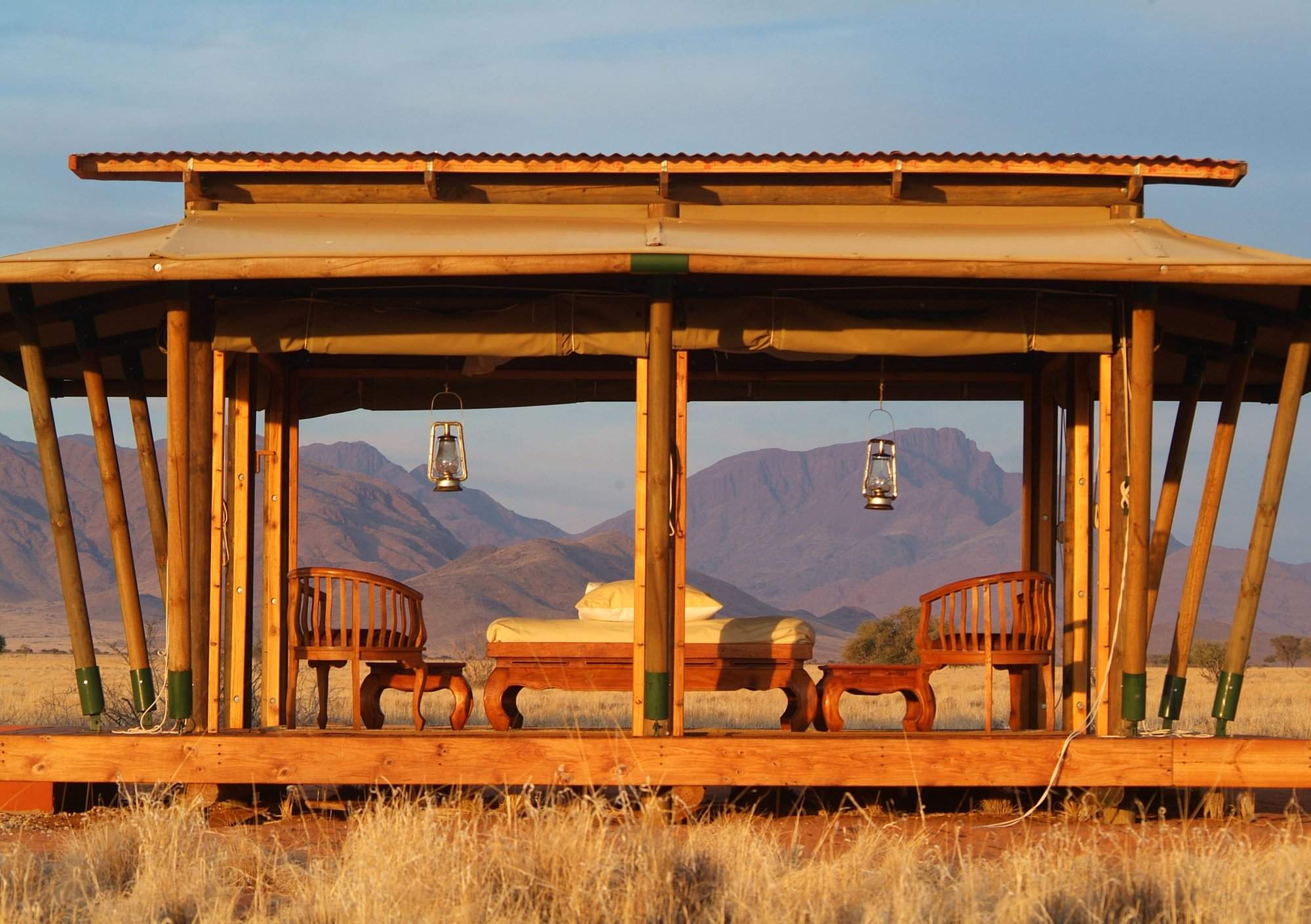
Wolwedans Plains Camp
With just three bedrooms, private chef and private guide, Wolwedans Plains Camp offers for peace and seclusion in a stunning setting.
When to go to NamibRand Nature Reserve
Our month by month guide: What it's like to visit Wolwedans Boulders in NamibRand Nature Reserve
Jan
Feb
Mar
Apr
May
Jun
Jul
Aug
Sep
Oct
Nov
Dec
Namibia in January
January is at the heart of Namibia’s rainy season. However, as you’d expect from a country dominated by desert and semi-desert environments, the rains are often (but not always) weak and usually quite localised. Some days will be clear, the strong sun raising temperatures to around 30ºC/86ºF; on others humidity and clouds build, sometimes culminating in spectacular thunderstorms. In extreme cases, these generate flash-floods which race down the beds of ephemeral rivers.
Across the country, the greening landscape makes a refreshing change, especially in desert areas. Many birds are in full breeding plumage and migrant species are here in force. In the north, where the rains are more reliable, the abundant water and food allows wildlife to disperse, making it trickier to spot.
- Variable weather: clear, hot & dry, or cloudy & humid with some rain
- Occasional, highly localised thunderstorms
- Many animals with young; birdlife at its most spectacular
- Wildlife dispersed & harder to see, especially in Etosha & the Caprivi
- Very few tourists (apart from the New Year) so rates mostly low
Our view
This is not a great time to visit
Weather in January
Namibia in February
February is the wettest month, but as Namibia is dominated by deserts, the rains are often weak and patchy. The variation in weather across Namibia is significant, too; the central highlands and Caprivi can see some heavy rain. More typically, some February days are clear with a hot, strong sun; others are cooler as cloudy skies build and, sometimes, culminate in short, spectacular thunderstorms. Occasionally these generate flash-floods, bringing ephemeral rivers to life and making travel more challenging.
Across the country, the landscape feels green and alive; insects and smaller animals are more easily seen, and many birds and animals are raising their young. However, small pools in the bush and thicker vegetation can make it hard to spot the wildlife.
- Variable weather: clear, hot & dry or cloudy & humid with some rain
- Occasional localised thunderstorms meander over the landscape
- The bush feels alive; birdlife is at its most spectacular
- Wildlife in Etosha & Caprivi is dispersed & harder to see
- Few tourists, so rates usually at their lowest
Our view
This is not a great time to visit
Weather in February
Namibia in March
March usually sees Namibia’s main rains tailing off, although actual precipitation varies hugely across the country and can be unpredictable from day to day. Many days will be clear, with a strong sun driving temperatures up. On others, clouds will build, and the late afternoon may see a short, spectacular thunderstorm. Such deluges reduce in both frequency and volume as the month progresses.
Across the country, landscapes are often vivid: a “green and pleasant land”. Many birds and animals are finishing raising their young, so smaller animals and insects are in evidence. In the north, where rains are generally heavier, pools in the bush and thicker vegetation can make it difficult to spot larger animals.
- Variable weather: clear, hot & dry or cloudy & humid with some rain
- Afternoon thunderstorms less common as March progresses
- Animals looking sleek and well-fed, after 3–4 months of plenty
- Wildlife in Etosha & Caprivi is dispersed & harder to see
- Few tourists visit during March, so rates often low
Our view
A good time to visit, with pros & cons
Weather in March
Namibia in April
Typically, April is dominated by dry weather; there’s an ever-decreasing chance of rain. Temperatures are now below their peak and continue to fall. Even so, days remain pleasant and warm, but there might be a slight chill in the air at night. The rains usually leave many parts of the country verdant and green, so animals are in fantastic condition – often with fast-growing young in attendance.
With the dust washed out of the atmosphere, photographers make the most of clear air, spectacular landscapes and healthy animals. Stargazers will have clearer night skies as the month progresses. In the game parks of Northern Namibia, water and food remain in plentiful supply, so finding big game can prove trickier than later in the year.
- Becoming drier &, especially at night, also cooler
- Few visitors, except around Easter, so rates remain low
- Wildlife in Etosha & Caprivi remains relatively hard to see
- Migrant birds have started to leave
- Fresh, clean air and often green, verdant landscapes
Our view
A good time to visit, with pros & cons
Weather in April
Namibia in May
By May, Namibia is usually drying out fast as the rains have ended. If they’ve been good, then the land remains green, but wildlife starts to congregate at more permanent water sources. Over much of the country the air quality and clarity can be amazing, making this an ideal month for photography.
Typical days are warm, with crisp, clear mornings and clear blue skies. Evenings are usually cool, and temperatures may dip below 10ºC (50ºF) overnight. Many lodges still charge “low season” prices, although with Namibia’s increasing popularity in recent years, some have started to introduce higher “shoulder season” rates.
May’s good-value rates, increasingly good wildlife sightings, beautiful landscapes and crystal-clear air combine to make this one of our favourite months in Namibia.
- Lovely weather: dry, warm days & cool nights
- The country is drying out although many landscapes remain green
- Fantastic air clarity – ideal for keen photographers
- Visitor numbers are often still low, mirrored by lodge rates
- Wildlife is starting to congregate more around remaining water
Our view
A very good time to visit
Weather in May
Namibia in June
Namibia is dry again. Skies are blue and usually largely cloudless. Days are lovely: warm and dry; nights are cold, sometimes below freezing in the desert. Most swimming pools in Namibia are always outdoors, making them too cold for all except the very dedicated.
Take a warm hat and gloves for game drives, where dawn and dusk will feel particularly chilly. In the north, especially Etosha, wildlife viewing is now into its dry-season pattern, focusing around the waterholes – though the park is still not busy.
Photographers come for superb air clarity, with minimal dust or smoke in the air. Historically, June rates have been low. However, with Namibia’s increasing popularity many lodges now count it amongst their “high-season” months, and request higher prices.
- Clear, bright days with blue skies; cold nights, mornings & evenings
- Great air quality, especially welcome for photographers
- “Shoulder season” for some lodges: lodge rates moderate
- Wildlife gravitates to waterholes, making game-viewing productive
- Some greenery in the landscape, depending on the last rains
Our view
A very good time to visit
Weather in June
Namibia in July
Reliably warm daytime temperatures (upwards of 20ºC/70ºF) and good wildlife sightings make this a popular month to visit Namibia. Rain would be very unusual indeed and clear skies make for great photographs. Once the sun sets, though, temperatures cool rapidly bringing cold nights that may dip below freezing in the desert. Be prepared: dress in layers and expect early-morning and late-afternoon drives, and anywhere coastal, to be cold.
As the land dries and vegetation shrivels, game congregates beside drinking water: Etosha’s waterholes are busy with animals. Across the country, lodges charge “high season” rates; many are fully booked a year or more in advance, especially during European school holidays (from the latter half of July to late August).
- Dry days, warm in the sun, with crisp, cold nights
- Cloudless skies: July is usually superb for stargazing
- The beginning of European school holidays so more families travelling
- Peak season: so high rates and many lodges fully booked far in advance
- A fantastic time of year for wildlife watching, particularly in Etosha
Our view
A very good time to visit
Weather in July
Namibia in August
August is the height of Namibia’s “winter”. Expect cloudless skies and plenty of warm sun in the day, but nights down to freezing in the desert. Dress in layers and bring warm clothes (including hats and gloves) for chilly starts and evenings. Only the hardiest even contemplate using outdoor pools.
It’s 3–4 months since any rain, so the land is dust-dry and much vegetation is golden brown. Many landscapes appear sparse and harsh. Wildlife congregates around available water sources, helping to guarantee good animal sightings.
Namibia is never really “busy” by the standards of Europe or the USA, but August is the most popular time to visit, especially for families. Book early (over a year in advance) if you want to stay at the best lodges.
- Dry days, warm in the sun; cold mornings, evenings & nights
- Cloudless skies in the day; spectacular stars at night
- Busy by Namibian standards: family rooms in particular demand
- Peak season: so high rates and many lodges fully booked far in advance
- A fantastic time of year for wildlife watching, particularly in Etosha
Our view
Fantastic: the very best time to visit
Weather in August
Namibia in September
September is a month of blue, cloudless skies and fantastic wildlife viewing. Rain is almost unheard of. As the month progresses, the days and nights get warmer. In some areas, daily maximums hit around the low 30s Celsius, although low humidity ensures this feels comfortable. The contrast makes the nights seem very cold. The air is becoming dustier, occasionally augmented by smoke from fires – so becoming hazy for photographic purists.
In the national parks, animals congregate around remaining water sources – making September one of the best months for game viewing. Hence it’s one of Namibia’s most popular months for visitors: a “high season” month that is often the time of choice for safari aficionados.
- One of the best months for wildlife viewing
- Warm days & cold nights, with temperatures rising during the month
- Many plants have faded from green to golden brown
- Air can be hazy – with dust & sometimes smoke
- High season rates; many lodges & camps are full 9 months in advance.
Our view
Fantastic: the very best time to visit
Weather in September
Namibia in October
Namibia is usually at its hottest and driest in October. Temperatures build as the month progresses; towards the end, daily highs may exceed 40ºC/100ºF, though with humidity close to zero, even this rarely feels oppressive.
In exceptional years, isolated rain showers may fall in late October. More usually, the end of the dry season sees wildlife watching at its best, particularly in Etosha. The place feels like a desert as spectacular herds of thirsty animals gather around the available water. October is popular amongst wildlife enthusiasts and commands peak-season prices, even if dust and smoke may make the air hazy, challenging photographers. Visitor numbers can fade towards the end of the month, allowing a window for last-minute bookings.
- Probably the most spectacular month for wildlife-viewing in Etosha
- Hot and dry: much of the country feels like a desert
- The air can be hazy with dust & smoke
- It’s peak time to visit, so expect high season rates
- Lodges & camps are full, especially early in October
Our view
A very good time to visit
Weather in October
Namibia in November
November is always a bit unpredictable: sometimes dry and hot; sometimes cloudier and cooler. Typically, mornings are hot and cloudless and clouds appear in the afternoon. Humidity builds and eventually breaks, resulting in spectacular thunderstorms that bring convection rainfall in late afternoons. Such storms are typically sparsely distributed and highly local – being completely absent from desert areas, for example. Places that do get good rain will flush green, with a tangible feeling of new life softening the landscapes. Many mammals give birth to their young.
Once any rains come, wildlife dissipates in search of food, and game viewing in Etosha becomes harder. Conversely, this is a great time for birdwatchers, with migrant species in breeding plumage.
- A very interesting, variable month, depending on the rains
- With rains come an amazing explosion of both vegetation & new life
- Wildlife viewing better in Damaraland than Etosha if it has rained
- Shoulder season: mid-range rates offer great value
- Away from the Namib, showers are more likely later in the month
Our view
A good time to visit, with pros & cons
Weather in November
Namibia in December
December is the first “proper” month of Namibia’s rainy season, and one of its hottest. Clear mornings give way to building clouds and, with luck, the occasional short, spectacular thunderstorm: refreshing and cleansing. These are often highly localised and generally warmly welcomed: most Namibians love rain!
Rains clear the air of dust. Even relatively short showers enable plant life to erupt, carpeting this thirstland in green and providing food for the young animals which abound. Animals disperse widely, which can make game viewing challenging. Many birds are breeding and so sporting their most colourful plumage.
Christmas and the New Year fall within local “summer holidays” – so places to stay can be surprisingly busy, especially in and around coastal towns, where temperatures are cooler.
- Hot and humid; sometimes refreshed by cooling showers
- Landscapes flushed green if/where there has been rain
- A tangible life and energy amidst this often green & pleasant land
- Very photogenic: blooming deserts amidst crystal-clear air
- Best time for birdwatchers; larger animals harder to spot
Our view
This is not a great time to visit
Weather in December

Looking for inspiration on where to travel next?
Visit our trip chooser to explore your options and find inspiration for your perfect African adventure
Inspire me